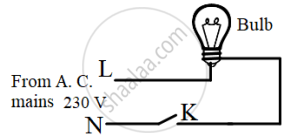Advertisements
Advertisements
Question
Answer the following question:
what is the heating effect of the electric current? state any four applications of it?
Solution
APPEARS IN
RELATED QUESTIONS
An electric iron of resistance 20 Ω takes a current of 5 A. Calculate the heat developed in 30 s.
An electric heater of resistance 8 Ω draws 15 A from the service mains 2 hours. Calculate the rate at which heat is developed in the heater.
How does the resistance of a wire vary with its area of cross-section?
Name any two effects of electric current.
The safety device based on the heating effect of electric current is called a ______.
An electric heater is connected to the 230 V mains supply. A current of 8 A flows through the heater.
(a) How much charge flows around the circuit each second?
An electric heater is connected to the 230 V mains supply. A current of 8 A flows through the heater.
(b) How much energy is transferred to the heater each second?
An electric room heater draws a current of 2.4 A from the 120 V supply line. What current will this room heater draw when connected to 240 V supply line?
What is nichrome? State its one use.
A resistance of 25 Ω is connected to a 12 V battery. Calculate the heat energy in joules generated per minute.
How much heat will an instrument of 12 W produce in one minute if it is connected to the heat produced by it?
The heat produced by passing an electric current through a fixed resistor is proportional to the square of:
(a) magnitude of resistance of the resistor
(b) temperature of the resistor
(c) magnitude of current
(d) time for which current is passed
The current passing through an electric kettle has been doubled. The heat produced will become:
(a) half
(b) double
(c) four time
(d) one-fourth
Which of the following characteristic is not suitable for a fuse wire?
(a) thin and short
(b) thick and short
(c) low melting point
(d) higher resistance than rest of wiring
The electrical resistivities of four materials P, Q, R and S are given below:
| P | `6.84xx10^8`Ωm |
| Q | `1.70xx10^8`Ωm |
| R | ` 1.0xx10^15`Ωm |
| s | `11.0xx10^-7`Ωm |
Which material will you use for making: (a) heating element of electric iron (b) connecting wires of electric iron (c) covering of connecting wires? Give reason for your choice in each case.
Solve the following example.
Heat energy is being produced in a resistance in a circuit at the rate of 100 W. The current of 3 A is flowing in the circuit. What must be the value of the resistance?
Solve the following example.
Two tungsten bulbs of wattage 100 W and 60 W power work on 220 V potential difference. If they are connected in parallel, how much current will flow in the main conductor?
Statement 1 : Electric current ( flow of electrons ) creates heat in the resistor.
Statement 2 : Heat in the resistor is created according to the rule of energy conservation.
Explain Statement 1 with the help of Statement 2.
Name any six domestic appliances based on the heating effect of electric current.
Answer the following question.
Write the mathematical expression for Joule's law of heating.
These days when current in the circuit suddenly increases _______ switches are used.
What is the heating effect of electric current?
Live wire and neutral wires have a 220 V potential difference.
True or False – If False give the correct answer
The fuse wire does not melts whenever there is overload in the wiring.
Mark the correct choice
- Assertion: Electric appliances with a metallic body have three wire connections.
- Reason: Three-pin connections reduce the heating of the connecting wires.
An electric iron consumes energy at the rate of 420 W when heating is at the maximum rate and 180 W when heating is at the minimum rate. The applied voltage is 220 V. What is the current in each case?
An electric bulb is connected to a 220 V generator. The current is 0.50 A. What is the power of the bulb?
(a) Observe the diagram given below and state whether the bulb will glow or not when we switch on K.

(b) Is it safe to handle the bulb when the switch is OFF?
(c) Give a reason for your answer in (b).
When a switch is in the OFF position,
(i) circuit starting from the positive terminal of the cell stops at the switch.
(ii) circuit is open.
(iii) no current flows through it.
(iv) current flows after some time. Choose the combination of the correct answers from the following.
Name two electric devices for each where
(i) the heating effect of current is used and
(ii) the magnetic effect of current is used.
What are the uses of electromagnets?
What is an electric fuse made up of?
Name the effect of the current responsible for the glow of the bulb in an electrical circuit.
In the electric equipment producing heat like iron, electric heater, boiler, toaster etc., an alloy such as nichrome is used, not pure metals.
